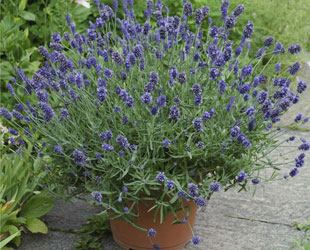8/27/2014
Growing A Magnificent Crop of Hardy Lavender
Jeremy Windemuller

In the garden, lavender is a durable, drought and deer resistant perennial. In production, it’s not so easy. Here’s a recipe for success when growing lavender in greenhouses and outdoor growing facilities.
Potting and timing
Like all evergreen perennials, bare root lavenders dry out quickly once they’re dug and packed for shipping, so they should be planted immediately upon receipt. Use a well-drained soil mix of peat, perlite and bark with a pH of 5.8 to 6.2. Set the crown of the plant just at the soil surface, taking care not to bury any branches. The lowest branches of the plant should be just touching the soil surface.
Pictured:Unlike most lavenders, which require a long vernalization to bloom, Sweet Romance flowers with little to no vernalization, making it a quick crop for growers—even those in southern climates.
Trials have shown that it’s far better to plant bare root lavender in spring rather than in fall. Plant later in spring if possible to take advantage of the naturally higher light levels, longer days and warmer temperatures that time of year. Use one bare root plant per true 1-gal. pot to finish in 8 to 10 weeks or one plant per 2-gal. pot to finish in just a few weeks longer—10 to 12 weeks. Lavender can also be planted from 72-ct plugs the summer prior into trade 1-gal. pots. They typically take 12 to 14 weeks to bulk up in late summer.
Cultural recommendations
Fertility: Lavender is a light-to-moderate feeder. Use 50 to 75 ppm Nitrogen constant liquid feed at every watering or 100 to 150 ppm Nitrogen as needed. Slow-release fertilizer should be applied at a rate of 1 to 1.5 lbs. per cubic yard of growing media. The recommended EC rate is 1.25 to 1.75 using the pour-through method.
Moisture: After potting up bare root lavender, water thoroughly to eliminate air pockets. To avoid foliar diseases and rot, irrigate early in the day to allow the foliage to dry before nightfall. Lavender doesn’t like to sit wet for any prolonged period. Water plants thoroughly and allow the soil to dry slightly between waterings.
Lighting: Lavender requires high light intensities to grow properly. It’s best to grow it at a time of year when light levels are naturally higher. If growing inside, grow it under clear plastic and space the crop well to prevent stretching, a loose habit and poor growth. Lavender can be forced into bloom under 16-hour days or using 4-hour night interruption lighting.
Temperature: Lavender grows best in cool conditions until the roots are established. Root and finish plants in 60 to 65F (15 to 18C) temperatures and hold them at 45 to 55F (7 to 12C) once they’re bulked up if desired. Once established in the landscape, lavender is very heat tolerant.
Pests and Diseases: Lavender can be subject to a number of pests and diseases. Prevention is key! Providing good ventilation and allowing plants to dry slightly between waterings will go a long way toward producing a healthy crop. At time of transplant, apply a broad-spectrum fungicide drench on both bare root and plug material to prevent root and crown rot. Watch for botrytis on dead leaves at the base of the plant and space plants well to avoid this issue. Phytophthora, pythium and septoria can also be problematic. Scout regularly for these diseases as well as aphids, caterpillars, leaf hoppers, spider mites and whiteflies.
Finishing tips
Trimming: People often ask about the proper time to trim lavender. In general production, it’s best not to trim lavender since that tends to invite in a number of diseases. Do not cut back the previous year’s foliage in spring if started from plugs the summer prior. Once finished plants are done flowering, the flower stems may be sheared back, taking care not to trim back the foliage.
Vernalization: Most varieties of lavender require 10 to 12 weeks of vernalization below 40F (4C) to flower consistently. Growers who are potting 72s the summer prior will need to be able to vernalize their crop in order for it to flower the following spring. Bare root plants received in spring will already have been vernalized by the supplier. One notable exception is Lavandula Sweet Romance, which doesn’t require vernalization to flower. This cultivar may be a better choice for growers looking for a quick crop, including southern growers.
Pinching and PGRs: Pinching isn’t recommended for lavender since it invites disease and most varieties shouldn’t require a PGR treatment. Large hedge-type lavenders like Phenomenal can be treated with uniconazol at a rate of 5 ppm or paclobutrazol at 30 ppm spray, applying 1 to 2 treatments 7 days apart when flower stems appear to control their height. When grown outdoors, plants will stay naturally more compact.
Growing Lavender Outdoors: Growing lavender outdoors is highly recommended in Zones 6 and warmer. It takes a little longer than growing plants indoors, but the finished product is far superior in habit, flowering performance and flower color. Start by planting bare root lavenders in early spring, placing them outside in full sun under a heavy 3-oz. frost blanket on drip irrigation once temperatures are consistently above freezing. Remove the blanket when daytime temperatures are above 40F (4C) and cover them again at night if temperatures fall below freezing.
Forcing: Lavender can be forced into bloom throughout the year. Provide 16-hour days or a 4-hour night interruption with a minimum of 10 foot candles of light intensity. Finished plants forced in 64 to 68F (17 to 20C) temperatures will bloom in approximately 8 to 10 weeks.
GT
Jeremy Windemuller is a grower and trial manager for Walters Gardens, Inc. in Zeeland, Michigan.